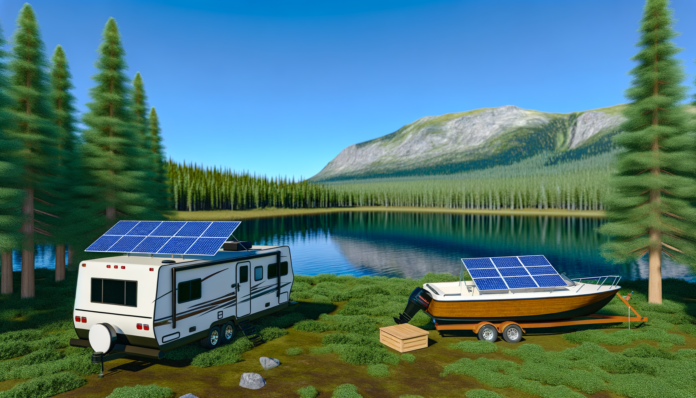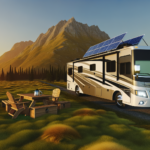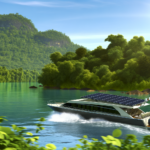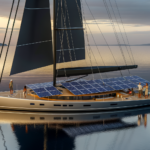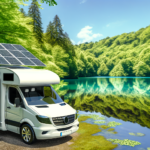Introduction to Eco-Friendly Adventures
The Rise of Sustainable Travel
In recent years, the concept of sustainable travel has gained significant traction among adventurers and outdoor enthusiasts. As awareness of environmental issues grows, more people are seeking ways to minimize their ecological footprint while exploring the great outdoors. This shift has led to an increased interest in eco-friendly travel options, such as using renewable energy sources to power recreational vehicles (RVs) and boats. Solar power, in particular, has emerged as a popular choice for those looking to embrace sustainable travel without sacrificing comfort or convenience.
Why Solar Power is Ideal for RVs and Boats
Solar power is an excellent solution for RVs and boats for several reasons. Firstly, it provides a clean and renewable source of energy, reducing reliance on fossil fuels and decreasing greenhouse gas emissions. Solar panels can be installed on the roofs of RVs and boats, harnessing the sun’s energy to generate electricity. This electricity can then be used to power various appliances and devices, making it possible to enjoy modern conveniences while off the grid.
Additionally, solar power systems are relatively low-maintenance and can be tailored to meet the specific energy needs of different users. Whether you’re a weekend warrior or a full-time traveler, solar power can provide a reliable and sustainable energy source for your adventures.
Benefits of Using Solar Power
The benefits of using solar power for your RV or boat are numerous and compelling:
- Environmental Impact: Solar power is a clean and renewable energy source that helps reduce your carbon footprint. By harnessing the sun’s energy, you can significantly decrease your reliance on non-renewable resources like fossil fuels.
- Cost Savings: While the initial investment in solar power systems can be substantial, the long-term savings are considerable. Once installed, solar panels generate free electricity, reducing or even eliminating the need for expensive fuel or campground hookups.
- Energy Independence: Solar power allows you to enjoy greater self-sufficiency. With a well-designed solar power system, you can travel to remote locations without worrying about finding a power source. This independence enhances the sense of freedom and adventure that comes with RV and boat travel.
- Quiet Operation: Unlike traditional generators, solar panels operate silently. This means you can enjoy the peace and tranquility of nature without the constant hum of a generator in the background.
- Low Maintenance: Solar power systems require minimal maintenance. Regular cleaning of the panels and occasional checks of the system components are usually sufficient to keep everything running smoothly.
- Increased Property Value: Installing a solar power system can increase the value of your RV or boat. As more people become interested in sustainable travel, having a solar power system can make your vehicle or vessel more attractive to potential buyers.
In conclusion, the rise of sustainable travel has led to a growing interest in eco-friendly energy solutions for RVs and boats. Solar power stands out as an ideal choice due to its environmental benefits, cost savings, energy independence, quiet operation, low maintenance, and potential to increase property value. By harnessing the power of the sun, you can embark on eco-friendly adventures without compromising on comfort or convenience.
Understanding Solar Power Systems
Basic Components of a Solar Power System
A solar power system for RVs and boats typically consists of several key components that work together to harness and utilize solar energy. These components include:
- Solar Panels: These are the most visible part of the system. They capture sunlight and convert it into electricity.
- Charge Controller: This device regulates the power flow from the solar panels to the batteries, ensuring they do not get overcharged.
- Batteries: They store the electricity generated by the solar panels for later use.
- Inverter: This component converts the DC power from the batteries into AC power, which is needed for most appliances inside the RV or boat.
How Solar Panels Work
Solar panels are made up of photovoltaic (PV) cells, which generate electricity when sunlight strikes their surface. Here’s a step-by-step breakdown of the process:
- Photon Absorption: When sunlight hits the PV cells, it excites the electrons within the silicon material, creating an electrical current.
- Electricity Generation: This direct current (DC) is then transferred to a charge controller, which regulates the flow of electricity to the battery bank.
- Energy Storage: The stored energy in the batteries can be accessed as needed.
- Power Conversion: An inverter converts the DC power to AC power for use with appliances and devices within the RV or boat.
By harnessing solar energy, RV and boat owners can enjoy a more sustainable and cost-effective source of electricity for their travels.
Types of Solar Panels Suitable for RVs and Boats
When it comes to choosing solar panels for RVs and boats, there are three main types to consider: monocrystalline, polycrystalline, and thin-film panels. Each type has its own set of characteristics and advantages.
Monocrystalline Solar Panels
Monocrystalline panels are made from a single crystal structure, making them highly efficient and compact. They are known for their sleek design and smooth appearance, making them a popular choice for RV and boat owners who prioritize aesthetics. Monocrystalline panels perform well even in low-light conditions and have a longer lifespan compared to other types of solar panels.
Polycrystalline Solar Panels
Polycrystalline panels are made from multiple silicon fragments, resulting in a distinctive mosaic-like appearance. Although they are slightly less efficient than monocrystalline panels, they offer a more cost-effective solution. Polycrystalline panels are also known for their good performance in high-temperature environments, making them suitable for boating in warmer climates.
Thin-Film Solar Panels
Thin-film solar panels are lightweight and flexible, offering a versatile option for RVs and boats with limited installation space. They are made by depositing thin layers of photovoltaic material onto a substrate. While thin-film panels are generally less efficient than crystalline panels, they can perform better in low-light conditions and have excellent resistance to shade or partial shading. Their flexibility allows for unique installation possibilities, such as mounting on curved surfaces.
In summary, understanding the basic components of a solar power system, how solar panels work, and the types of solar panels suitable for RVs and boats is crucial for anyone looking to harness solar energy for their outdoor adventures. By making informed choices, you can ensure that your solar power system meets your specific needs and enhances your eco-friendly travels.
Setting Up Solar Power for Your RV
Assessing Your Power Needs
Before diving into the world of solar power for your RV, it’s crucial to assess your power needs. Start by identifying all the electrical appliances and devices you plan to use. Common power-hungry appliances include air conditioners, microwaves, refrigerators, and electric stoves. Calculate the wattage of each device and estimate the daily usage in hours. Multiply the wattage by the hours of use to get the total watt-hours (Wh) consumed per day. For example, a 90-watt television used for 2 hours a day consumes 180 Wh (90W x 2h). Summing up the watt-hours for all devices will give you a clear picture of your daily energy consumption.
Choosing the Right Solar Panels
Selecting the appropriate solar panels for your RV involves understanding the different types available and their suitability for your needs. There are three main types of solar panels: monocrystalline, polycrystalline, and thin-film. Monocrystalline panels are the most efficient and space-saving, making them ideal for RVs with limited roof space. Polycrystalline panels are less efficient but more affordable. Thin-film panels are flexible and lightweight but generally less efficient. Additionally, consider whether you want fixed, flexible, or portable panels. Fixed panels are mounted permanently on the roof, flexible panels can contour to the RV’s shape, and portable panels can be moved to optimize sun exposure.
Installation Process
Installing solar panels on your RV can be a DIY project or done by professionals. Here’s a step-by-step guide for a DIY installation:
1. **Mounting the Panels**: Choose a location on the roof with maximum sun exposure. Use mounting brackets to secure the panels. Ensure the panels are angled correctly to capture the most sunlight.
2. **Wiring**: Connect the solar panels to a charge controller using appropriate gauge wires. The charge controller regulates the voltage and current going to the battery to prevent overcharging.
3. **Battery Connection**: Connect the charge controller to the battery bank. Ensure the batteries are properly ventilated and secured.
4. **Inverter Installation**: Install an inverter to convert the DC power stored in the batteries to AC power, which is used by most RV appliances.
5. **Testing**: Once everything is connected, test the system to ensure it’s working correctly. Check the charge controller display to monitor the power flow and battery status.
Maintenance Tips
Maintaining your RV solar power system is essential for optimal performance and longevity. Here are some tips:
– **Regular Cleaning**: Keep the solar panels clean from dust, dirt, and debris. Use a soft cloth and mild detergent to clean the panels periodically.
– **Inspect Connections**: Regularly check all electrical connections for signs of wear or corrosion. Tighten any loose connections and replace damaged wires.
– **Monitor Battery Health**: Keep an eye on the battery levels and health. Ensure the batteries are not overcharged or deeply discharged, as this can reduce their lifespan.
– **Check for Obstructions**: Ensure that no objects are shading the panels, as even partial shading can significantly reduce their efficiency.
– **Seasonal Adjustments**: Depending on your travel locations, you may need to adjust the angle of the panels seasonally to maximize sun exposure.
By carefully assessing your power needs, choosing the right solar panels, following a meticulous installation process, and adhering to regular maintenance, you can harness the power of the sun to enjoy a more sustainable and independent RV lifestyle.
Harnessing Solar Power for Your Boat
Unique Challenges of Marine Solar Power
Harnessing solar power for boats presents unique challenges that differ from those encountered with RVs. The marine environment is harsh, with constant exposure to saltwater, high humidity, and intense UV radiation. These conditions can accelerate the wear and tear on solar panels and other electrical components. Additionally, the movement of the boat, whether from waves or wind, can affect the stability and efficiency of the solar power system. Space is also a premium on boats, making it crucial to optimize the placement and size of solar panels to ensure they do not interfere with the vessel’s operation or aesthetics.
Selecting Marine-Grade Solar Panels
When selecting solar panels for marine use, it is essential to choose marine-grade options designed to withstand the harsh conditions of the sea. **Marine-grade solar panels** are typically more robust and durable, featuring corrosion-resistant materials and enhanced UV protection. There are several types of solar panels suitable for boats, including:
- Monocrystalline Panels: Known for their high efficiency and compact size, making them ideal for limited space on boats.
- Polycrystalline Panels: Generally more affordable but slightly less efficient than monocrystalline panels.
- Flexible Panels: Lightweight and can be mounted on curved surfaces, offering versatility in installation.
When choosing panels, consider factors such as efficiency, durability, and the available installation space on your boat.
Installation Guidelines
Installing solar panels on a boat requires careful planning and execution to ensure optimal performance and longevity. Here are some key guidelines:
- Assess the Available Space: Identify suitable locations for mounting the panels, such as the deck, cabin roof, or railings. Ensure the panels will not obstruct any essential functions or pathways.
- Optimize Panel Placement: Position the panels to maximize sun exposure throughout the day. Consider using adjustable mounts to change the angle of the panels as needed.
- Secure Mounting: Use marine-grade mounting hardware to secure the panels firmly. This will help withstand the constant movement and vibrations of the boat.
- Wiring and Connections: Use marine-grade wiring and connectors to prevent corrosion and ensure reliable electrical connections. Route the wiring through waterproof conduits to protect against water ingress.
- Integrate with Existing Systems: Connect the solar panels to a charge controller, which regulates the power flow to the batteries. Ensure the system is compatible with your boat’s electrical setup.
Maintenance and Safety Considerations
Maintaining your marine solar power system is crucial for ensuring its efficiency and longevity. Here are some maintenance and safety tips:
- Regular Cleaning: Salt and grime can accumulate on the panels, reducing their efficiency. Clean the panels regularly with fresh water and a soft cloth to remove any buildup.
- Inspect for Damage: Periodically check the panels, wiring, and connections for any signs of wear, corrosion, or damage. Address any issues promptly to prevent further deterioration.
- Monitor Performance: Use a monitoring system to track the performance of your solar power setup. This can help identify any drops in efficiency or potential problems early on.
- Safety Precautions: Ensure all electrical components are properly insulated and protected from water ingress. Use circuit breakers and fuses to prevent electrical overloads and short circuits.
By addressing these unique challenges and following best practices for selection, installation, and maintenance, you can effectively harness solar power for your boat, ensuring a reliable and eco-friendly energy source for your marine adventures.
Maximizing Efficiency and Performance
Optimal Panel Placement
Proper placement of solar panels is crucial for maximizing their efficiency and performance. For both RVs and boats, the goal is to ensure that the panels receive the maximum amount of sunlight throughout the day. Here are some tips for optimal panel placement:
- Orientation: Position the panels to face the sun directly. In the northern hemisphere, this typically means angling the panels southward. For boats, this might require adjustable mounts to account for changes in direction.
- Tilt Angle: Adjust the tilt angle of the panels to match the latitude of your location. This helps in capturing the maximum amount of solar energy. Some RV and boat owners use adjustable mounts to change the tilt angle seasonally.
- Avoid Shading: Ensure that the panels are free from shadows cast by objects like antennas, vents, or masts. Even partial shading can significantly reduce the efficiency of solar panels.
- Surface Area: Utilize as much available surface area as possible. For RVs, this often means the roof, while for boats, it could include the deck or even the sails if using flexible panels.
Battery Storage Solutions
Efficient storage of the energy generated by your solar panels is essential for ensuring a reliable power supply. Here are some key considerations for battery storage solutions:
- Battery Type: Choose between lead-acid, AGM (Absorbent Glass Mat), or lithium-ion batteries. Lithium-ion batteries are generally more efficient, lighter, and have a longer lifespan, making them ideal for both RVs and boats.
- Capacity: Assess your energy needs to determine the appropriate battery capacity. This involves calculating the total watt-hours required to power your devices and appliances during periods without sunlight.
- Battery Management System (BMS): Invest in a good BMS to protect your batteries from overcharging, deep discharging, and other potential issues. A BMS can significantly extend the life of your batteries.
- Placement: Install batteries in a well-ventilated area to prevent overheating. For boats, ensure the battery compartment is waterproof and secure.
Monitoring and Managing Your System
Effective monitoring and management of your solar power system are vital for maintaining its efficiency and performance. Here are some strategies to consider:
- Solar Charge Controller: Use a high-quality solar charge controller to regulate the voltage and current coming from the solar panels to the batteries. MPPT (Maximum Power Point Tracking) controllers are more efficient than PWM (Pulse Width Modulation) controllers.
- Energy Monitoring Systems: Install an energy monitoring system to keep track of your power generation and consumption. These systems can provide real-time data and alerts, helping you optimize your energy usage.
- Regular Maintenance: Perform regular maintenance checks on your solar panels, batteries, and electrical connections. Clean the panels to remove dust and debris, and inspect the wiring for any signs of wear or corrosion.
- Software and Apps: Utilize software and mobile apps designed for solar power systems. These tools can help you monitor performance, predict energy production, and even diagnose issues remotely.
By focusing on optimal panel placement, efficient battery storage solutions, and diligent monitoring and management, you can maximize the efficiency and performance of your solar power system, ensuring a reliable and sustainable energy source for your RV or boat adventures.
Case Studies and Real-Life Examples
RV Owners’ Experiences with Solar Power
Many RV owners have embraced solar power to enhance their travel experiences while reducing their environmental impact. Here are a few inspiring stories:
The Off-Grid Enthusiast: Jane and Mark, a couple from Colorado, decided to retrofit their RV with a solar power system to enjoy off-grid living. They installed 400 watts of solar panels on the roof and a 200Ah lithium battery bank. This setup powers their lights, refrigerator, and even a small air conditioner. Jane mentions, “We love the freedom solar power gives us. We can camp in remote locations without worrying about running out of power.”
The Full-Time RVers: John and Lisa have been living in their RV full-time for over three years. They opted for a 600-watt solar panel system paired with a 300Ah battery bank. “Solar power has been a game-changer for us,” says John. “We save a lot on campground fees because we don’t need to hook up to electricity. Plus, it’s great knowing we’re reducing our carbon footprint.”
Boaters’ Success Stories
Boaters are also finding solar power to be a reliable and eco-friendly energy source. Here are some notable examples:
The Silent Cruiser: Tom, an avid sailor, converted his sailboat to run on solar power. He installed 300 watts of marine-grade solar panels and a 150Ah battery bank. “The best part is the silence,” Tom says. “I can sail for hours without the noise of a generator. It’s just me and the sound of the waves.”
The Eco-Friendly Charter Business: In a coastal town, a charter boat company decided to make a green change. They converted their entire fleet to electric propulsion systems powered by solar panels and deep cycle batteries. This eco-conscious move not only reduced emissions but also attracted environmentally conscious customers. Now, their electric boats offer breathtaking tours without harming the marine ecosystem.
Lessons Learned and Best Practices
Both RV owners and boaters have gathered valuable insights from their experiences with solar power. Here are some key lessons and best practices:
- Assess Your Power Needs: Before installing a solar power system, accurately assess your energy consumption. This will help you choose the right size for your solar panels and battery bank.
- Invest in Quality Components: High-quality solar panels, batteries, and inverters may have a higher upfront cost but offer better performance and longevity.
- Optimal Panel Placement: Ensure your solar panels are placed where they can receive maximum sunlight. For RVs, this often means mounting them on the roof. For boats, consider flexible panels that can be placed on the deck.
- Regular Maintenance: Keep your solar panels clean and check connections regularly to ensure optimal performance. For marine applications, use marine-grade components to withstand harsh conditions.
- Monitor Your System: Use a monitoring system to track your energy production and consumption. This helps in identifying any issues early and optimizing your energy use.
By sharing these real-life examples and lessons learned, we hope to inspire more adventurers to consider solar power for their RVs and boats. The benefits are clear: reduced environmental impact, cost savings, and the freedom to explore off-grid locations.
Future Trends in Solar Power for Outdoor Adventures
Innovations in Solar Technology
The field of solar technology is rapidly evolving, bringing forth innovations that promise to revolutionize how we harness solar power for outdoor adventures. One of the most exciting developments is the advent of **flexible solar panels**. Unlike traditional rigid panels, these can be bent and shaped to fit various surfaces, making them ideal for RVs and boats. They are lightweight, portable, and can be rolled up for easy transport, offering unparalleled versatility.
Another significant innovation is the integration of **smart technologies** with solar panels. Advanced systems now come equipped with IoT (Internet of Things) capabilities, allowing users to monitor and manage their solar power systems remotely via smartphone apps. This technology provides real-time data on energy production and consumption, enabling more efficient use of solar power.
**Transparent solar panels** are also on the horizon. These panels can be integrated into windows, providing a dual function of generating electricity while allowing light to pass through. This innovation could be particularly useful for RVs and boats, where space is at a premium.
The Growing Community of Solar-Powered Adventurers
As awareness of environmental issues grows, so does the community of eco-conscious travelers. More adventurers are turning to solar power to reduce their carbon footprint and embrace sustainable travel. Social media platforms are buzzing with hashtags like #SolarPoweredAdventures and #EcoFriendlyTravel, reflecting a growing trend.
This community is not just limited to individual travelers. **Online forums and social media groups** dedicated to solar-powered adventures are flourishing, providing a platform for enthusiasts to share tips, experiences, and advice. These communities are invaluable for newcomers looking to make the switch to solar power, offering support and inspiration.
Moreover, the rise of **solar-powered events and meetups** is fostering a sense of camaraderie among like-minded adventurers. These gatherings provide opportunities to showcase the latest in solar technology, share success stories, and discuss best practices, further strengthening the community.
How to Stay Updated and Involved
Staying updated with the latest trends and innovations in solar power is crucial for anyone looking to maximize their eco-friendly adventures. Here are some ways to stay informed and involved:
1. **Follow Industry News**: Subscribe to newsletters and follow reputable websites that cover advancements in solar technology. Websites like Solar Power World and CleanTechnica offer regular updates on the latest innovations and trends.
2. **Join Online Communities**: Participate in forums and social media groups dedicated to solar-powered travel. Platforms like Reddit, Facebook, and specialized forums such as SolarPanelTalk are excellent resources for real-time advice and community support.
3. **Attend Workshops and Webinars**: Many organizations and companies offer workshops and webinars on solar power. These events are a great way to learn from experts, ask questions, and stay updated on the latest technologies.
4. **Engage with Manufacturers**: Follow the social media accounts and blogs of leading solar panel manufacturers. Companies like BougeRV often share updates on new products, innovations, and practical tips for using solar power in outdoor settings.
5. **Read Case Studies and Reviews**: Learning from the experiences of others can provide valuable insights. Look for case studies and reviews from fellow adventurers who have successfully integrated solar power into their travels.
By staying informed and engaged, you can make the most of the latest advancements in solar technology, ensuring your outdoor adventures are as eco-friendly and efficient as possible.


